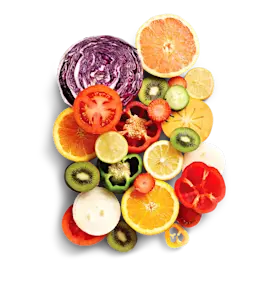The FDA Takes Action: The Facts and Significance of the Red Dye No. 3 Ban
The FDA Takes Action: The Facts and Significance of the Red Dye No. 3 Ban
The FDA Takes Action: The Facts and Significance of the Red Dye No. 3 Ban
Feb 12, 2025
John McCurdy
A little more than a year after the state of California banned the use of red dye No. 3 as a food and beverage additive, the U.S. Food and Drug Administration (FDA) has followed suit, revoking its long-standing authorization of the compound in food and ingested drugs. The synthetic colorant is known to be carcinogenic at high doses for animals and may carry other health risks (covered in greater detail below).
Most often used in candies, frozen novelties, frostings and processed fruit products, red dye No. 3 has already been phased out either mostly or entirely by many major brands. That said, Center for Science in the Public Interest (CSPI) found more than 9,000 food products containing the once-popular additive in the U.S. Department of Agriculture’s Branded Foods Database, hundreds of which are made by an unnamed group of “the country’s biggest food companies.”
Manufacturers using the compound in food have until January 15, 2027, to reformulate or discontinue their affected products, while those using it in ingested drugs have until January 18, 2028. All food and drugs imported to the U.S. will also have to comply with the ban.
So that you can fully understand the situation, including red dye No. 3’s rise and fall, as well as the scientific research done to reveal its negative effects, we've collected the most important information for you below. Plus, we've tapped our in-house expert for insights and rounded up examples of how food software solutions can help your business adjust.
How We Got Here: The History of Red Dye No. 3
Red dye No. 3, also known as erythrosine, is a petroleum-based derivative of fluorone synthesized from phenol and phthalic anhydride, which are processed into fluorescein and then iodinated. Swiss chemist Karl Kussmaul discovered the compound in 1876, and soon after it was commercialized by a local chemical company for dyeing wool and silk.
In the U.S., the Pure Food and Drug Act of 1906—the same legislation that established the FDA—made the colorant permissible for use in food. This came under scrutiny in the 1970s and early 1980s, when research linked the dye with thyroid cancer in male rats, rendering its authorization a violation of the Delaney Clause (which in part “prohibits the FDA from approving a color additive that is ingested if it causes cancer in animals or humans”).
The FDA chose to continue allowing it, however, citing the conclusions of the Center for Food Safety and Applied Nutrition and Cancer Assessment Committee that humans developing cancer by ingesting the small amounts of the compound as food coloring was unlikely, and that the biological mechanism that makes the dye cause cancer in rats does not occur in humans.
Still, most public health groups in the U.S. maintained their stance on red dye No. 3 and advocated for its banning over the decades. Meanwhile, the EU and California passed their bans (albeit more than 30 years apart), and 10 other U.S. states, including New York, Pennsylvania and Washington, introduced legislation to do the same across 2023 and 2024.
The FDA cited a November 2022 petition submitted by several consumer health advocacy groups, including the Center for Science in the Public Interest (CSPI), in its explanation of the banning decision. The dye had already been banned for use in cosmetics and topical drugs by the FDA in 1990, and the European Union banned it altogether in 1994, with some exceptions for maraschino cherries.
Why It’s Being Banned: The Health Risks of Red Dye No. 3
The research done on male rats linking red dye No. 3 and thyroid cancer involved “chronic ingestion” of the colorant, which resulted in overstimulation of the thyroid by the hormone thyrotropin. These experiments did not follow a typical ingestion pattern—the rats consumed much more of the dye, much more frequently, than humans would—and the mechanism causing thyroid overstimulation does not exist in humans.
Still, the fact that the compound was proven to be carcinogenic makes its permissibility illegal under the Delaney Clause. Additional research published in 2012 confirmed the original finding on the dye through additional testing on rodents and also found other similar synthetic dyes—red dye No. 40, yellow dye No. 5 and yellow dye No. 6—to include benzidine and other carcinogens.
As for other potential health risks, researchers concluded that red dye No. 3 and other food colorings “are not a main cause of attention deficit hyperactivity disorder, but they may contribute significantly in some cases” in a different report published in 2012. What’s more, in 2021, the California Office of Environmental Health Hazard Assessment found the compound can make children more vulnerable to behavioral issues, including decreased attention.
What It All Means: The Significance of the Ban
Representatives of the CSPI and Environmental Working Group, along with university professors familiar with the facts of the situation, have celebrated the ban, with the consensus among them being that it is an overdue step toward better food safety in the U.S. Our internal expert, Drew Pogones, PdH, agrees.
“The FDA’s decision to ban red dye No. 3 in food and ingested medications is a long-overdue step toward improving consumer safety and expectations after 30-plus years in the making,” he said. “While progress is welcome and needed, we in the U.S. still lag behind other countries in regulating food additives and chemicals.”
“After seeing the compliance deadlines set for 2027 for food and 2028 for ingested medications, it’s worth asking ourselves, ‘Will this spark broader action to align with global food safety standards?’ Only time will tell,” he concluded.
What is certain is that food and beverage businesses that have not already removed red dye No. 3 from their products will need to replace or remove the colorant in those recipes ahead of the enforcement date. Natural extracts of fruits and vegetables, like those from beets and radishes, are good substitutes for red coloring, as is carmine, a dye derived from cochineal insects.
Industry-specific product lifecycle management (PLM) software is the solution of choice for making these sorts of alterations thanks to formulation management features and a vendor portal that facilitates sourcing new ingredients from suppliers. Food enterprise resource planning (ERP) software is another must-have, with product specification capabilities to standardize recipes and inventory management to track raw materials.
Aptean: Your Partners in Food Safety Technology
This ban of red dye No. 3 may not have quite as dramatic of an effect on the food industry as it might have 30 years ago given that many manufacturers have ceased using the colorant in the interim. But it will still require a significant amount of recipe review and product reformulation on the part of businesses.
And it’s not the only way the FDA is setting food safety standards higher, as the Food Traceability Final Rule is due to come into effect in July 2028. It’s a big step up in terms of record-keeping requirements for companies dealing with certain high-risk foods, and a big step forward in the establishment of the new Human Foods Program, which represents a new era in regulation.
As compliance in the food industry gets ever more challenging, it’s a good idea to reassess your food and beverage business’s technology stack and determine if you have the tools you need to meet today’s food safety benchmarks. Should you find yourself in need of a PLM or ERP system like those we’ve described, Aptean should be at the top of your list of providers given our proven track record and deep expertise in the industry.
What’s more, our solutions are AI-enhanced and cloud-based, giving you the latest in cutting-edge functionality and airtight cybersecurity. Aptean Food & Beverage ERP offers unique industry-specific technology built on the Microsoft Dynamics 365 Business Central platform, putting it in the upper echelon for quality, accessibility and modularity.
If you’d like to learn more about our food ERP software and its potential to improve your organization’s operations, contact us today or request a personalized demo.
Related Content





Food Manufacturing Metrics That Matter
Food manufacturers rely on data to make decisions regarding their organization’s operations. Data provides visibility into process efficiency—however, not all data should be weighed equally. How do you know which metrics to prioritize for decision making?



